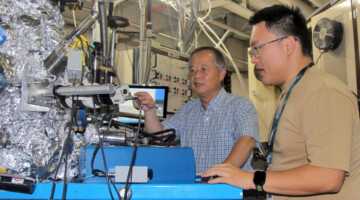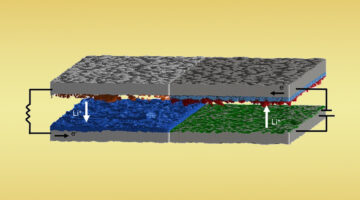-
-
-
-
- Trick or treatise? How much energy is packed in that candy bar?
- Itinerant magnetism and superconductivity in exotic 2D metals for next-generation quantum devices
- Photo review: Nuclear Scout Day at the Lab
- Six ways Berkeley Lab is helping to bring clean hydrogen to the world
- Creating a lithium-ion battery for the future
- Science comedian Brian Malow visits Berkeley Lab
- NASA Ames’ contributions to OSIRIS-REx
- High-performance, earth-friendly materials for geothermal wells
-
-
-
Internal Currents in Lithium Batteries after Fast Charging
In lithium batteries after fast charging, researchers measured the persistence of internal currents and found that large local currents continue even after charging has stopped. The work uses hard x-ray 3D imaging in a novel way and sheds light on the causes of thermal runaway and the catastrophic failure of lithium batteries at rest. Read more »![]()
![]()
Improving Carbon Retention in Grassland Soil from Point Reyes
Soil organic carbon directly influences the life-supporting services provided by soils, including the production of food and the regulation of atmospheric carbon dioxide. To better understand how minerals such as calcium affect carbon accumulation in soil, researchers studied soils collected from Point Reyes National Seashore. Read more »![]()
HyMARC Aims to Hit Targets for Hydrogen Storage Using X-Ray Science
Understanding how materials absorb and release hydrogen is the focus of the Hydrogen Materials Advanced Research Consortium (HyMARC). At the ALS, the HyMARC Approved Program was recently renewed, underscoring the key role that soft x-ray techniques have played in addressing the challenges of hydrogen storage. Read more »
Spectroscopic investigation of a Co(0001) model catalyst during exposure to H2 and CO at near-ambient pressures
We have performed near-ambient-pressure X-ray photoelectron spectroscopy on Co(0001) model catalysts during exposure to gases relevant to Fischer–Tropsch synthesis, i.e., CO and H2, at 0.25 mbar total pressure. At this pressure, CO seems to be more efficient at keeping the Co(0001) surface metallic than H2, which is the opposite behavior as reported in the literature for other pressure ranges. Read more »
A Deep-Learning Analysis of Lithium-Plating Dynamics in Batteries
Lithium-metal solid-state batteries are a promising technology, but the deposition (plating) of lithium metal on electrode surfaces remains a significant technical hurdle. Here, researchers used micro-computed tomography data to train an artificial intelligence model to identify characteristics vital to improving battery performance. Read more »![]()
How Structure Affects the Activity of Lipid Nanoparticles
Berkeley Lab and Genentech scientists related the internal structures of lipid nanoparticles to their efficacy at drug delivery, using a combination of methods including x-ray scattering at the ALS. The work promises to expedite the development of drug delivery systems for the treatment of diseases such as COVID-19 and cancer. Read more »![]()
![]()
ALS in the News (September 2023)
-
-
-
-
- Berkeley Lab awarded two new centers to counter climate change [CIWE/Ethan Crumlin]
- Accelerating sustainable semiconductors with ‘multielement ink’
- Fast-track strain engineering for speedy biomanufacturing
- SLAC fires up the world’s most powerful x-ray laser: LCLS-II ushers in a new era of science
- DOE selects five Berkeley Lab projects for FAIR awards [Emerging Properties through Controlled Phase Transformations for High Energy Sodium Ion Batteries/Wanli Yang]
- Scientists probe the source of key hydrocarbons on Earth—and in space
- Berkeley Lab launches research projects to support national biopreparedness and response efforts [Taskforce 5/Greg Hura]
- ‘Computer vision’ reveals unprecedented physical and chemical details of how a lithium-ion battery works
- Ana Kupresanin tapped to lead Berkeley Lab’s Scientific Data Division
- BCSB confirms design of stimulus-responsive, two-state proteins
-
-
-
Accelerating Sustainable Semiconductors With ‘Multielement Ink’
Scientists have developed “multielement ink”—the first “high-entropy” semiconductor that can be processed at low temperature or room temperature. The new semiconducting material could accelerate the sustainable production of next-gen microelectronics, photovoltaics, solid state lighting, and display devices. Read more »
Insight into How Thermoresponsive Nanomaterials Work
By combining soft x-ray scattering with electron microscopy, researchers learned how nanoscale polymer assemblies in solution restructure in response to heating. The approach can be generalized to many complex, solution-phase, nanoscale processes, and holds promise for driving advances in applications from drug delivery to catalysis. Read more »![]()
![]()
- « Previous Page
- 1
- …
- 10
- 11
- 12
- 13
- 14
- …
- 83
- Next Page »






